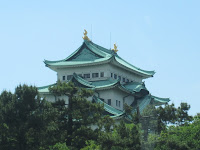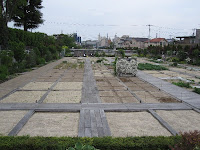

I visited Nagakute Town and Seto City near Nagoya City in Aichi Prefecture.
Nagakute is a town with a population of about 50 thousands. It locates in the eastern suburb of Nagoya.
Nagakute is a town with a population of about 50 thousands. It locates in the eastern suburb of Nagoya.
A famous battle named "the battle of Komaki Nagakute"was held here in the late 16th century.
The town is also famous as it co-hosted “the 2005 World Exposition, Aichi, Japan” with Seto City and Toyota City.
I took “Linimo” or magnetic levitation train from Fujigaoka, Nagoya's eastern border to Expo Memorial park Station in Nagakute Town. Two nagnetic levitation train system are under commercial operation in the world and Linimo is one of them (the other one is in Shanghai). The line is 8.9 kilometers long.
The train is lifted by 8 millimeters by magnetic power and runs smoothly along the rail. It accelerates and slows down quicker than ordinary trains. It can turn small corners and makes less noises when it runs. It was so confortable.
 The town has Toyota Automobile Museum. About 120 classic cars were displayed. They drove a 18th century-style automobile for us. It was a replica of one of the oldest engine cars. So exciting.
The town has Toyota Automobile Museum. About 120 classic cars were displayed. They drove a 18th century-style automobile for us. It was a replica of one of the oldest engine cars. So exciting.
The 2005 Expo site was converted into a park and business and cultural facilities. One of them is a market named “Agurinmura”. They sell local vegetables and other agricultural products. I bought fresh bamboo and miso paste. They were cheap.
The western part of the town is residential area. People commute from the area to Nagoya to work and study. There remain fields and woods in the eastern part ot the town.
 Toyotomi Hideyoshi, the ruler of Japan in the late 16th century, and Tokugawa Ieyasu, who became the ruler after Hideyoshi’s death and opened Edo Shogunate Government in the early 17th century, had a battle in Nagakute in 1584. The battle field has turned into a park. Local people showed us “Bonote” or symbolized marshal art performances, in the park.
Toyotomi Hideyoshi, the ruler of Japan in the late 16th century, and Tokugawa Ieyasu, who became the ruler after Hideyoshi’s death and opened Edo Shogunate Government in the early 17th century, had a battle in Nagakute in 1584. The battle field has turned into a park. Local people showed us “Bonote” or symbolized marshal art performances, in the park.
Many cities and towns produce porcelains in Japan, but Seto is probably the most famous name among them. Seto-mono (the products of Seto) often means porcelain in Japan.
The history of the city's porcelain production is more than 1000 years.
They can find good clay in many places in the city, which is the reason behind the development of the industry.
 I visited a craft center (factory). The master showed us how he made his products. He tactically touched the clay on a turning plate and produced cups, dishes and other porcelains. It was amazing. He said that he made nearly 500 products a day when necessary.
I visited a craft center (factory). The master showed us how he made his products. He tactically touched the clay on a turning plate and produced cups, dishes and other porcelains. It was amazing. He said that he made nearly 500 products a day when necessary.
I bought some dishes at the shop of the center.
There are many porcelain shops in the city.
I took “Linimo” or magnetic levitation train from Fujigaoka, Nagoya's eastern border to Expo Memorial park Station in Nagakute Town. Two nagnetic levitation train system are under commercial operation in the world and Linimo is one of them (the other one is in Shanghai). The line is 8.9 kilometers long.
The train is lifted by 8 millimeters by magnetic power and runs smoothly along the rail. It accelerates and slows down quicker than ordinary trains. It can turn small corners and makes less noises when it runs. It was so confortable.
 The town has Toyota Automobile Museum. About 120 classic cars were displayed. They drove a 18th century-style automobile for us. It was a replica of one of the oldest engine cars. So exciting.
The town has Toyota Automobile Museum. About 120 classic cars were displayed. They drove a 18th century-style automobile for us. It was a replica of one of the oldest engine cars. So exciting.The 2005 Expo site was converted into a park and business and cultural facilities. One of them is a market named “Agurinmura”. They sell local vegetables and other agricultural products. I bought fresh bamboo and miso paste. They were cheap.
The western part of the town is residential area. People commute from the area to Nagoya to work and study. There remain fields and woods in the eastern part ot the town.
 Toyotomi Hideyoshi, the ruler of Japan in the late 16th century, and Tokugawa Ieyasu, who became the ruler after Hideyoshi’s death and opened Edo Shogunate Government in the early 17th century, had a battle in Nagakute in 1584. The battle field has turned into a park. Local people showed us “Bonote” or symbolized marshal art performances, in the park.
Toyotomi Hideyoshi, the ruler of Japan in the late 16th century, and Tokugawa Ieyasu, who became the ruler after Hideyoshi’s death and opened Edo Shogunate Government in the early 17th century, had a battle in Nagakute in 1584. The battle field has turned into a park. Local people showed us “Bonote” or symbolized marshal art performances, in the park.Many cities and towns produce porcelains in Japan, but Seto is probably the most famous name among them. Seto-mono (the products of Seto) often means porcelain in Japan.
The history of the city's porcelain production is more than 1000 years.
They can find good clay in many places in the city, which is the reason behind the development of the industry.
 I visited a craft center (factory). The master showed us how he made his products. He tactically touched the clay on a turning plate and produced cups, dishes and other porcelains. It was amazing. He said that he made nearly 500 products a day when necessary.
I visited a craft center (factory). The master showed us how he made his products. He tactically touched the clay on a turning plate and produced cups, dishes and other porcelains. It was amazing. He said that he made nearly 500 products a day when necessary.I bought some dishes at the shop of the center.
There are many porcelain shops in the city.
Before visiting Nagakute and Seto, I watched Nagoya Castle. It was originally built in the 17th century.

















































